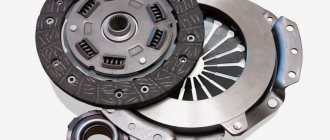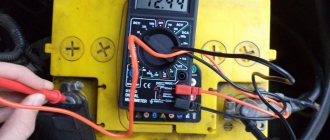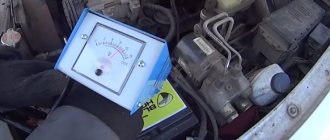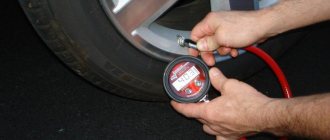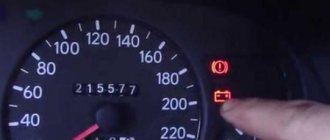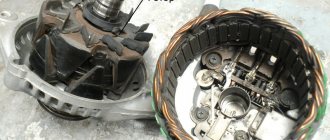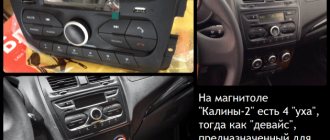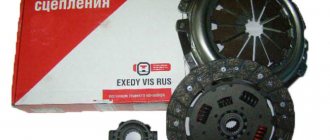To start the engine, it must rotate intensively. It is carried out using a starter, which is powered by a battery. It is she who transmits to him the necessary electricity to start the engine. The battery is the source of power supply for all elements of the car, so the battery is the most important component, without which it is impossible to operate the car.
Characteristics of the standard Kalina battery
The manufacturer installs a domestically produced Akom brand battery under the hood of the Lada Kalina. Owners of Kalina, Kalina 2, Grants, Priora and other AvtoVAZ models who bought their cars with this power source complain about its poor quality. There have been cases when batteries were replaced after just a couple of months under warranty.
The nominal capacity of the Akom battery is 55 A/h, and the starting current is 425 Amperes. These are the minimum acceptable values, and using a battery with lower characteristics is not advisable.
The standard battery is the most common, lead type, filled with acid. The temperature range allowing normal use is from +45°C to -40°C.
We select the battery according to technical characteristics
Selecting a battery for any car should begin with assessing the technical characteristics you need. This will help you determine which items in the store you should look at more closely. You must decide on the capacity of your future battery, but leave all other features the same as the factory offers. The capacity can be quite large even in a small battery with modern technologies, so it is much better to buy a fairly high-quality version of the battery, which is no different in size from the factory offering for Kalina. In this case, you can get many advantages and the following technical characteristics:
- capacity from 55 Ah – you can choose a battery with a capacity of 65 Ah to slightly extend the life of the device;
- the starting current is 425 A - these are factory characteristics that are important for the normal operation of your battery;
- The battery is lead-acid, you should not experiment with gel power source options for domestic cars;
- a battery of a well-known brand has a certain trust on your part, because otherwise it is better to refuse the purchase;
- the cost corresponds to other representatives of this segment of the same class with the same technical characteristics;
- the presence of frost protection, as indicated in the documents or on the battery case - the maximum operating temperature should be low.
There are many features that determine the technical characteristics of the optimal purchase for you. Car batteries are often not of the highest quality and do not meet the specified technical characteristics, so it is better to choose a battery not only according to factory data, but also according to important additional criteria. You may prefer battery options whose names you have already heard of, and the reviews say a lot of good things. You can also chat with other Kalina owners, since the factory battery on a car becomes unusable within 3-4 years.
When is it time to change the battery and why?
Owners of Lada Kalina are well aware that replacing the battery is necessary after three to four years of active use. It all depends on various factors, for example, on the quality of the battery, on the energy consumption of the vehicle’s on-board network. But not everyone knows by what signs one can determine that it is time to think about a new battery for the Lada Kalina, because the specified period is determined conditionally. For this reason, everyone should understand when to change the battery to avoid problems associated with the inability to start the engine. Among the main signs indicating the need to replace the battery:
- The engine starts with difficulty not only in winter, but also in summer. This means that the power supply cannot hold a charge.
- The indicator lamp for the need to charge the battery lights up on the instrument panel. The on-board computer, if available, can also signal this.
- After a long trip (more than 15 km), a measurement with a multimeter shows insufficient charge. The device must be fully charged from the generator, if the latter is working.
- Once fully charged, the density measurement shows less than 1:25 Gm/cm. You can try to level the indicator with a corrective electrolyte; if this does not help, it is better to replace the battery.
- The electrolyte has darkened. This occurs due to the destruction of the lead plates. The use of such a battery is prohibited as it may cause an explosion.
- If the battery emits an unpleasant smell of putrefactive decomposition.
- You can turn on the radio for an hour with the engine off. If after this the engine starts with difficulty, this means that the battery is draining too quickly and it’s time to change it.
- If the battery lasts more than four years, then it's time to buy a new one.
If any of these symptoms occur, you may need to purchase a new power supply for your vehicle soon.
In some cases, you can extend the battery life by using corrective electrolyte and additional charging.
Signals that it’s time to change the battery
There are several indicators that indicate that the battery has “outlived its usefulness” or needs to be fixed. For example, when the battery light is on. This indicates that there is a malfunction in the battery. You will have to fix it yourself or at a service station, or go to the store for a new device.
However, there are situations when even after replacing the battery the problem does not disappear: the battery icon is still on. But this already indicates that it is not the battery that is in order, but the generator of your car.
And here's something else you should know: when the battery is not charging, this is not always a cause for concern. The battery may die due to something other than a problem. This can be caused by the headlights not being turned off, as well as the radio being in an active state when the engine is not running.
So is it possible to equip your car with a “long-lasting battery”? Yes, definitely. If you follow simple rules for selecting and operating this device.
How to choose a battery for Lada Kalina
The issue of choosing a replacement for an old battery must be approached responsibly. There are several important criteria, each of which is worth considering in detail.
Brand
Western countries use much more advanced technologies in the production of batteries. They even check in a completely different way. In our country, the charge is tested with a load fork, with the help of which the load is applied for 10 seconds, and the charge should not fall below 9 V. The European test involves 30 seconds of load with the same minimum threshold of the “drawdown” voltage. As a result, Russian batteries are inferior in quality to their foreign counterparts. It cannot be said that there are no brands on our market that are not inferior in quality to European ones, but there are not many of them. And you shouldn’t focus only on a popular brand; characteristics and compliance with the required parameters are much more important.
Date of manufacture
Proper storage of batteries is important. If the charging rules were violated, or the devices were in aggressive conditions of unacceptable temperatures, then their characteristics will be distorted even before they are purchased and installed under the hood. The best option is that the device was manufactured no more than four months ago. You should be very careful when buying a battery that has been stored for a year or more. Checking with a load fork is mandatory.
Capacity
Capacity selection is a broad topic and there is a lot of controversy surrounding it. But it all comes down to the fact that you need to choose a battery with a capacity no lower than the factory one. More is possible, but not less. In everything you need to know when to stop and understand that a battery with a large capacity simply will not fit in its rightful place due to its increased size.
Starting current
This parameter is indicated directly on the battery. It is not recommended to buy a battery with a starting current lower than the minimum declared for the Lada Kalina. The same amount or more is allowed. At subzero temperatures, the battery can lose up to 40% of its charge, and insufficient starting current may not cope with the difficulty of starting a frozen engine. In this matter, you need to find a middle ground, since options with a high starting current are quite expensive.
Polarity
The battery can be with direct or reverse polarity. This means that the terminals can be in opposite places. It is worth considering this when choosing a device. The cost of models with reverse polarity is somewhat lower, but installing them on Kalina, where direct polarity is provided, will not be easy.
Load fork test
Mandatory procedure before purchase. Usually, sellers themselves, without unnecessary requests, perform a load fork test in front of the buyer. To do this, voltage is applied to the battery for at least 10 seconds. The battery charge during this time should not drop to less than 9 V, otherwise it is not worth purchasing the device.
Guarantee
If a manufacturer gives a guarantee for its product for up to 5 years of operation, this indicates reliability and high quality. But the price tag for such batteries is unreasonably high. The optimal warranty period at an affordable price is from two to three years. These are honest numbers that correspond to the service life of the battery. If the warranty is only for a year, this is a reason to think about it. A short warranty period is given for a reason; it is not recommended to buy such products.
What kind of battery is needed?
Please note that each battery has its own passport. As a rule, it contains parameters and capabilities. When purchasing a new battery for a car, take into account the fact that the operation of your car in the future will be completely dependent on this important device. If you approach the choice irresponsibly, you can develop a number of problems during operation and even significantly reduce the life of your car.
Find out what AvtoVAZ employees don’t know! Lada Kalina Hatchback characteristics. All the secrets of the car!
So, first analyze the characteristics of the old one. Pay attention to the starting current! It must certainly be the same or slightly higher than that of your old battery. If you are sure that the starting current is completely appropriate, then you still should not purchase a completely new battery for a car that has a lower capacity. And all because a small capacity, even with a normal starting current of a new battery, will certainly lead to the formation of a high degree of discharge. And this is not good for the car, because ultimately the battery life is reduced significantly. But there are exceptions to the rules. The indicator can be increased, but only if you become the owner of additional equipment for the car. Among them may be various devices, as well as car gadgets.
Batteries of this type have another imperfection, namely, in operating modes that imply a large electrical load on the car (for example, frequent idling of the engine in constant combination with light driving during daylight hours). In this case, the battery begins to work together with the generator in the dark, and this, in turn, significantly reduces the battery life. As for the non-electrical parameters, namely the location of the terminals, the size of the battery, as well as the mounting option for the car battery, everything is very clear and understandable. All you have to do is look at the mounting location and make your choice.
Antimony battery
The founder of all lead batteries. It got its name from the addition of a small percentage of antimony to lead, which made it less “soft.” Due to the rapid process of electrolysis, when when charging from 12.5 V to 12.7 V, it seems that the electrolyte is boiling, the expression “the battery is charged if it boils” arose.
The advantage of such batteries is their lead plates, which are strong enough to withstand deep discharges and not crumble. The disadvantage is the need to constantly monitor the electrolyte level in the banks. The liquid takes up more volume than the plates, which means that such batteries are limited in capacity and inrush current.
Antimony batteries are difficult to maintain due to the fact that they cannot be made sealed. The violent release of gases from electrolysis can simply rupture the housing.
Calcium batteries
Calcium batteries replaced the obsolete antimony batteries. Instead, calcium was added to lead plates. The choice of this element should minimize the evaporation of water during the electrolysis process. In fact, this is a maintenance-free type of battery.
Some manufacturers add a small percentage of silver to the composition, which reduces the internal resistance, allowing for increased capacitance and inrush current. Calcium devices have low self-discharge. There are more plates here, but less liquid; they do not boil, since electrolysis requires 16 V.
But there are also disadvantages - such batteries are very sensitive to deep discharges. It is enough to discharge it several times, and it immediately loses up to 80% of its capacity. It is also necessary to take into account the high cost of relatively antimony ones - the difference in price can be three times different.
Battery selection options?
These criteria are an essential condition when choosing a battery:
- the existing active substance of the negative electrode contains a pore expander to ensure excellent delivery of the necessary electricity to consumers at different temperatures;
- The positive electrodes contain an additive that significantly increases strength, as well as resistance to heavy loads and prevents corrosion, while significantly improving charge acceptance;
- high starting current, which is capable of starting the car engine, even at very low uncomfortable temperatures, even down to -55°C;
- The design of the cover with built-in flame arresters is an excellent indicator of safety during battery operation, and also provides reliable protection against explosion in the event of an accidental spark.
- The separator used is polyethylene, which is an envelope type made of microporous polyethylene. This property makes it possible to eliminate short circuits and at the same time ensures reliable and stable current output from the plates;
- composition of the entire battery case. Ideally, it should be impact-resistant and also frost-resistant. It is good if the housing design has a comfortable handle, as well as insulating caps for all poles;
- low self-discharge is an important indicator that ensures a high level of performance in various conditions, which involve temperature changes, as well as the presence of various vibrations.
Which battery is best for a VAZ car? Which battery manufacturer is the best? Which battery is better? If you analyze all the latest data about specific models, and also consider in detail the reviews of car owners, you can make an approximate rating of car batteries. That's what we did. Our rating allows us to reliably answer the question of which battery is best suited.
We present to your attention the rating of car batteries based on operating time without error:
OPTIMA is a very compact battery that is perfect for starting completely different car engines. Thanks to the good battery power (up to 1050A), it is possible to easily start a multi-liter diesel truck engine in the lowest temperatures. OPTIMA has the ability to function equally well at temperatures from -40°C to +40°C. This type of battery is very sealed and does not contain free electrolyte. This allows you to install it in absolutely any position. Even upside down if desired.
VARTA is the most famous Western manufacturer in Russia. The battery of this brand is a very high-quality product that has good technical performance. Currently, the VARTA brand belongs to Johnson Controls Inc., which is located in Germany. The company has quite a lot of experience in the manufacture of rechargeable batteries. This brand is perfect in its original configuration for cars such as Ford, Peugeot, Volvo, BMW. Most batteries for VARTA cars are produced in the Czech Republic, followed by countries such as Spain, France, and the ranking is completed by Germany and Austria - here VARTA batteries are produced in very small quantities. If we talk about Russia, then our batteries are produced in the Standart series, they have a white case. TUDOR – It should be noted here that TUDOR has invented a sealed battery system that prevents leakage of liquid electrolyte. Emissions of vapors during operation in this battery are also not allowed. The company actively developed the technology of such sealed batteries, and they were also the first to fill the battery with a special gel instead of liquid electrolyte. Such innovative production methods allowed Tudor to create batteries with starter currents that were many times greater than those of similar manufacturers. I would like to note that the dimensions of the battery and its operation have not changed at all. TUDOR functions perfectly in completely different operating modes.
Of course, many of the brands presented are also produced in Asian countries under license, but, as practice shows, it is better to give preference to brands produced by the manufacturer. Often their quality is significantly higher than analogues from other countries in Europe or America.
Hybrid batteries
As you might guess from the name, manufacturers tried to combine all the best qualities from the two technologies. The battery also consists of plates, but one side is antimony and the other is calcium. The characteristics of this element turned out to be average - a universal among batteries. Water consumption is at an average level, increased capacity and starting current are not too sensitive to discharge and are in the average price segment.
Helium batteries should not be considered because of their unreasonably high price and relatively low performance that does not justify the cost, although such batteries are more powerful.
Removing and installing the battery
You can remove and install the battery only in strict compliance with the order of connecting/disconnecting the terminals, as well as the polarity. The process looks like this:
- Open the hood.
- Remove the cover from the “+” terminal.
- Loosen the bolt connection of the negative terminal and disconnect it.
- Loosen the bolt connection of the “positive” terminal and disconnect it.
- Remove the battery.
Installing the battery in its rightful place is done in the reverse order. In this case, you need to be careful and take into account that any battery has considerable weight.
Removing the battery
You will need a 10 and 13 wrench. Or heads with a ratchet, but they are inconvenient to work with.
This is what you need to click on.
Removed the terminals to the sides.
Install the battery in the reverse order.
Causes
The most common reason is charging the battery.
There's not much to write home about here. The battery is removed for:
Let's briefly consider options with charging and overnight stays.
Charger
We do not recommend charging the battery in the car. At a minimum, remove the terminals and unscrew the plugs.
During the charging process, the battery emits harmful gases, which, if they get on the car body, can cause corrosion. So I remove the battery and put it aside.
Check for acid.
Overnight
In a warm environment, the battery will retain its properties (in simple terms, it will not lose capacity) and it will be easier to start the car.
Charging the battery
The battery itself does not produce electric current; its function is only to store it. The necessary supply of electricity in the battery is maintained by the generator, constantly recharging it. The battery life depends on the number of charge and discharge cycles. The more there are, the smaller the capacity becomes. Gradually, the battery is able to store less and less current - eventually there may not be enough to start the engine. In this case, you can revive the battery and charge it using various devices.
Before you start charging, there are several important factors to consider. The charging current should correspond to 10% of the rated capacity, that is, if the latter is 55 A/h, then the optimal current should be no more than 5-6 A. The voltage at the terminals should exceed the rated voltage by 10%. If a charged and serviceable battery shows 12.6 V, then the voltage at the charging terminals should be 13.86 V. The battery must be properly charged for a long time and at low current values. You can quickly charge the battery at a current of up to 30 A, but this method is detrimental to the plates.
Preparing to charge
Before charging the battery, you need to make sure it is discharged, and to do this it should be removed from its original place. During operation, a natural discharge is observed, but the device can also discharge due to damage to the case, when the electrolyte leaks through cracks and the chemical process is disrupted. The presence of a crack can be detected by severe oxidation of the terminals. Operation of such a power source is prohibited.
Manufacturers often use a special indicator plug, the color of which can be used to determine whether recharging is needed. All information can be found in the product passport.
The easiest and most effective way to check the charge level is to measure it with a multimeter. The device will show the exact voltage. Based on these readings, a decision is made about the need for charging.
The next step is to check the electrolyte level. This can be done through the filler holes. The electrolyte must completely cover the plates, be transparent and clean, no debris or clouding is allowed. If the level is low, you need to add distillate.
Alternative batteries
If you don’t know which battery should be installed on the Lada Kalina, then when choosing from the proposed list, consider the following details:
Dimensions - for LADA Kalina they should be the following 242/175/190 and this is mandatory, because other drives may not fit, which will turn out to be a serious problem. In particular, design changes will have to be made to the body.
| Manufacturer (country) | Marking | Capacity, Ah | Cold start current, A | Guarantee | Price |
| Varta (Czech Republic) | Blue Dynamic D43 | 60 | 540 | 1 year | 3300 RUR |
| Mutlu (Türkiye) | SFB M3 6CN-60.1 | 60 | 540 | 2 year | 4300 RUR |
| AUTOPOWER (Czech Republic) | A60-L2X | 60 | 540 | 3 years | 5200 RUR |
Comparing the presented battery models for Lada Kalina, the best
can also be highlighted. Of course, when purchasing, many will say, why are you offering me expensive batteries, especially since two of them even have a shorter warranty period? In fact, the production technologies of Russian and Czech batteries are different. The Western competitor's are more progressive, since they were not adopted in an outdated form from Germany.
Therefore, if you suddenly face the question of which one is better to buy, then we will recommend the Czech AUTOPOWER brand battery from those offered. It is 2 thousand more expensive, but in terms of its characteristics it is clearly better. Of course, if you use the battery in an exceptionally warm climate without sudden overheating, then the Russian one will also last the full 5 years, but when alternating winter and summer climates, it is better to install this particular source. Its active paste does not spill out, the electrodes do not become corroded, and the electrolyte does not evaporate. On average, such a battery can last at least 5 years.
After installation, the engine started up instantly, literally with half a turn, but this took into account that about an hour ago I turned it with the starter several times until the old battery died. I also tried to start it at night, around 23:30 Moscow time. At this moment, the engine temperature was 26 degrees. The first time it cranked perfectly, but at idle, and on the second attempt the engine started without any problems.
55 or 60 – that’s the question... Many motorists are scratching their heads over which battery to choose. Or maybe it's not so scary after all? Or maybe you shouldn’t bother with this?
Everything is possible. Let's figure it out.
To start. Which battery should you not buy at all?
When choosing a battery, look not only at the numbers, but also at the designation after them.
If the capacity on the label (although this value is not exactly a capacity, more on that below) is designated “Ah”, do not mess with such a product. This suggests that the battery is produced by some company called “Horns and Hooves,” whose specialists didn’t even bother to understand the units of measurement. The correct option is “A•h” (amps multiplied by hours). And nothing else!
And now about the capacity
All of us (to be honest, and even many sellers along with manufacturers) are convinced that Amp-hours are used to indicate the battery capacity. But no. Let's remember the school (or university) physics course. What was the capacity measured in it? That's right, Farads. And the product A•h gives Coulombs (C), which are used to measure the amount of charge. To be more precise – 1 A•h=3600 C.
But it just so happens that when talking about Amp-hours, they mean the capacity of the batteries. And it is very, very difficult to eradicate such an established stereotype. Let's not try to do this, because... efforts will be useless.
And now about overcharging, undercharging and other misconceptions
Of course, the best option when choosing a battery for a car is to simply go and buy a battery for as many Amp-hours as is written in the manual for the car. But we are not looking for easy ways.
If we summarize the opinions of numerous experts, amateurs and ordinary motorists, an approximate picture of the applicability of 55 Ah batteries will look like this (we repeat, it is approximate, see the manual):
Is it possible to take a “sixty” for such cars? Yes, you can.
According to your passport, you need a 55 Ah battery, but you took a 60 Ah battery. Will it be undercharged and will the generator break?
No no and one more time no. You should not believe the myths of “experts” who say that the generator “will not be able to handle” a battery with a larger capacity than stated by the manufacturer. It will pull, it will pull.
